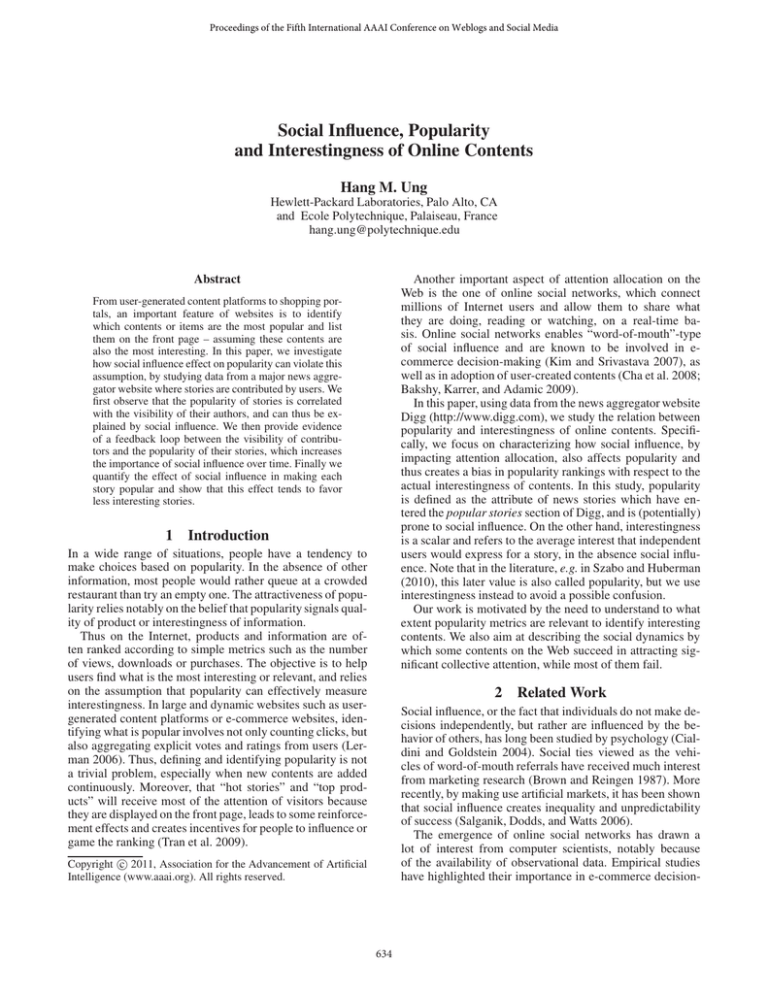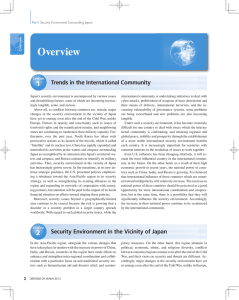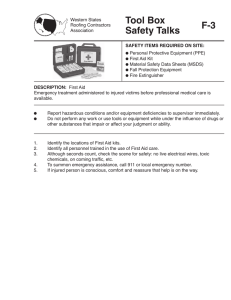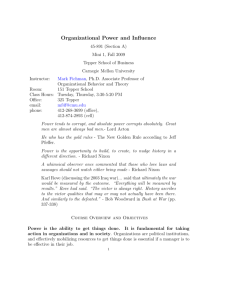
Proceedings of the Fifth International AAAI Conference on Weblogs and Social Media
Social Influence, Popularity
and Interestingness of Online Contents
Hang M. Ung
Hewlett-Packard Laboratories, Palo Alto, CA
and Ecole Polytechnique, Palaiseau, France
hang.ung@polytechnique.edu
Another important aspect of attention allocation on the
Web is the one of online social networks, which connect
millions of Internet users and allow them to share what
they are doing, reading or watching, on a real-time basis. Online social networks enables “word-of-mouth”-type
of social influence and are known to be involved in ecommerce decision-making (Kim and Srivastava 2007), as
well as in adoption of user-created contents (Cha et al. 2008;
Bakshy, Karrer, and Adamic 2009).
In this paper, using data from the news aggregator website
Digg (http://www.digg.com), we study the relation between
popularity and interestingness of online contents. Specifically, we focus on characterizing how social influence, by
impacting attention allocation, also affects popularity and
thus creates a bias in popularity rankings with respect to the
actual interestingness of contents. In this study, popularity
is defined as the attribute of news stories which have entered the popular stories section of Digg, and is (potentially)
prone to social influence. On the other hand, interestingness
is a scalar and refers to the average interest that independent
users would express for a story, in the absence social influence. Note that in the literature, e.g. in Szabo and Huberman
(2010), this later value is also called popularity, but we use
interestingness instead to avoid a possible confusion.
Our work is motivated by the need to understand to what
extent popularity metrics are relevant to identify interesting
contents. We also aim at describing the social dynamics by
which some contents on the Web succeed in attracting significant collective attention, while most of them fail.
Abstract
From user-generated content platforms to shopping portals, an important feature of websites is to identify
which contents or items are the most popular and list
them on the front page – assuming these contents are
also the most interesting. In this paper, we investigate
how social influence effect on popularity can violate this
assumption, by studying data from a major news aggregator website where stories are contributed by users. We
first observe that the popularity of stories is correlated
with the visibility of their authors, and can thus be explained by social influence. We then provide evidence
of a feedback loop between the visibility of contributors and the popularity of their stories, which increases
the importance of social influence over time. Finally we
quantify the effect of social influence in making each
story popular and show that this effect tends to favor
less interesting stories.
1 Introduction
In a wide range of situations, people have a tendency to
make choices based on popularity. In the absence of other
information, most people would rather queue at a crowded
restaurant than try an empty one. The attractiveness of popularity relies notably on the belief that popularity signals quality of product or interestingness of information.
Thus on the Internet, products and information are often ranked according to simple metrics such as the number
of views, downloads or purchases. The objective is to help
users find what is the most interesting or relevant, and relies
on the assumption that popularity can effectively measure
interestingness. In large and dynamic websites such as usergenerated content platforms or e-commerce websites, identifying what is popular involves not only counting clicks, but
also aggregating explicit votes and ratings from users (Lerman 2006). Thus, defining and identifying popularity is not
a trivial problem, especially when new contents are added
continuously. Moreover, that “hot stories” and “top products” will receive most of the attention of visitors because
they are displayed on the front page, leads to some reinforcement effects and creates incentives for people to influence or
game the ranking (Tran et al. 2009).
2 Related Work
Social influence, or the fact that individuals do not make decisions independently, but rather are influenced by the behavior of others, has long been studied by psychology (Cialdini and Goldstein 2004). Social ties viewed as the vehicles of word-of-mouth referrals have received much interest
from marketing research (Brown and Reingen 1987). More
recently, by making use artificial markets, it has been shown
that social influence creates inequality and unpredictability
of success (Salganik, Dodds, and Watts 2006).
The emergence of online social networks has drawn a
lot of interest from computer scientists, notably because
of the availability of observational data. Empirical studies
have highlighted their importance in e-commerce decision-
c 2011, Association for the Advancement of Artificial
Copyright Intelligence (www.aaai.org). All rights reserved.
634
making (Kim and Srivastava 2007) or adoption of usercreated contents such as pictures (Cha et al. 2008), or objets
and places in virtual worlds (Bakshy, Karrer, and Adamic
2009). Theoretical approaches have also been explored to
study information flow or adoption behaviors in networks,
often with models borrowed from the study of epidemics
(e.g., Wu et al. 2004).
Both empirical and theoretical works consider the social
networks as a static conveyors of information, whereas we
adopt the view that in fact, links are created according to the
dynamics of information. From that perspective, our work
is also related to the broader physics literature on networks
dynamics, for instance Barabasi and Albert (1999).
With respect to the issue of popularity, a previous result
is that the popularity of contributed contents is related to the
visibility (i.e. the number of links in the social network) of
their authors (Lerman 2006; Wu, Wilkinson, and Huberman
2009). Our work clearly builds upon this observation and
the existence of a “tyranny of the minority” whereby a small
group of contributors controls de facto what is popular (Lerman 2006).
identifier, the username of the submitter and timestamps of
submission and promotion time (if ever promoted). Each
digg record contains the username of the digger, a timestamp and the identifier of the story it is related to. Thus, we
are able to track all diggs from any individual users, as well
as to count all the diggs received by a particular story. We
also retrieved all the fan links between the users with the
timestamps of their creation.
3.2 Social influence analysis
To measure the effect of social influence, we constructed for
each popular story, a directed graph of diggs where vertices
are diggs in the upcoming phase. An edge pointing from A
to B means that B occured after A and user who dugg B is
a fan of user who dugg A. A is a parent digg and B a child
digg. A first approach to quantify social influence is to count
the proportion μup of child diggs.
However, a certain proportion μ0,up of edges is in fact explained by randomness, and is related to the average degree
of the social network (i.e. the average number of links per
user). Intuitively, the more people are connected, the more
likely independent diggs will appear as parent-child related.
Thus we offset this randomness by taking the social effect ν
to be equal to the difference: ν = μup − μ0,up
To approximate μ0,up , we observe that the same equation holds for the popular phase during which the number
of diggs that can be attributed to the social network is negligible (Szabo and Huberman 2010), and therefore the social
effect is zero. In addition, the network average degree varies
only very little during the lifetime of a story, and so does
the randomness term. Thus, μ0,up ≈ μ0,pop = μpop and
ν = μup − μpop
To reduce stochastic noise, we actually averaged μpop
over all stories submitted in a month and used that single
value μpop . During the period under consideration,μpop
increased from 0.05 to 0.3, reflecting an increase in the network average degree.
3 Methods
3.1
Digg, dataset and data processing
The purpose of the Digg website is to provide a digest of the
most interesting news-like content published on the Internet.
Digg aggregates and displays lists of stories, which are URL
to news articles, blog posts, videos or photos. Digg’s crowdsourcing scheme involves users both to submit (contribute)
stories and to digg (vote for) stories they liked. Following
their submission, all stories are displayed in the upcoming
page in a reverse-chronological order. Some stories receive
sufficient number of diggs in a limited period of time and are
then selected (promoted, in the Digg jargon) to be displayed
on the Digg homepage, where they are called popular stories.
Since hundreds of stories are submitted every hour, users
do not read them all. Instead, they mainly use two ways of
browsing stories. One is to browse popular stories displayed
on the Digg front page and another is to follow what other
users are digging (Szabo and Huberman 2010). Indeed, Digg
implements its own social network such that if user A becomes a fan of user B, A will then see what B has “dugg”
recently. Note these links are directed.
When a story has become popular, it undergoes a fast accumulation of diggs, the total amount of which we define as
its interestingness. That this number reflects the actual interestingness of the story is supported by results from Szabo
and Huberman (2010) showing that most diggs on popular
stories are not prone to social influence, because they come
mainly from users who are browsing popular stories listed
on the Digg front page.
Digg was launched in December 2004 but the social filtering features were released only in August 2005. Our dataset
consists of downloaded records of 108 million diggs on 6.1
million stories, from 3 distinct time periods: a) January 2007
- November 2007, b) June 2008 - July 2008, and c) December 2008 - May 2009. Each story record contains its unique
4 Results
As pointed out in Wu, Wilkinson, and Huberman (2009),
attention received by contributed contents increases with the
network of their authors. In the case of Digg, this translates
into the fact that the users who contribute popular stories
(call them successful users) also those who have a higher
number of fans (Lerman 2006).
We first verify this correlation by comparing for each
month in our dataset the average number of fans of successful users, to the average number of fans of all users
who have submitted at least one story during the month.
As expected, the ratio ρ of these two numbers is far greater
than 1 (Fig. 1a), highlighting the correlation between having a large number of fans and contributing popular stories.
Although our observation does not demonstrate causality,
previous empirical (Lerman 2006) and theoretical (Lerman
2009) studies on Digg have suggested there is a direct cause
effect.
We also observe that ρ increases until December, 2008.
To interpret this increase, one can view ρ as a measure of inequality in number of fans, between users who contributed
635
5
10
15
20
Months since Jan 2007
25
0.5
0.4
0.3
0.2
<ν> (average social effect)
100
0.0
0
0
c
0.1
150
b
50
δ(k) (Increase of fans in a month)
25
0
5
10
ρ
15
20
a
0
1
2
3
4
5
k (number of popular stories in a month)
0
5
10
15
20
25
Months since Jan 2007
Figure 1: a) Relative number of fans of successful submitters vs. all submitters (ρ). Users who submitted a story that became
popular are distinguished by a higher number of fans, as observed by ρ > 1. b) Acquiring new fans and submitting popular
stories. The increase in the number of fans during a month is correlated to the number of popular stories submitted in that
month. c) Evolution of social effect. The monthly averaged value ν, which measures the effect of social filtering in making
stories popular, has substantially increased until June, 2008 (x = 17).
popular stories and all users who contributed. Thus, the increase in ρ suggests that fan links are getting more unequally
distributed. Indeed, we observe that the 80% “poorest” users
(in number of fans) have had their share of the total number
of fans decreasing from 24% to 7% between March, 2007
and March, 2009 (not shown).
Thus, on Digg, popularity is explained by social influence. Besides, links in the social network are unequally distributed around successful users, and this inequality has increased. An explanation for this evolution is that success itself brings new fans. This would result in a positive feedback loop: users having many fans easily gain success which
in return, brings them new fans. To support this hypothesis,
we measured for each user i and each month j, the increase
in number of fans δi,j between the start and the end of the
month. We restricted our analysis to the months between October 2007 and July 2008, within which most of the network
growth is concentrated. Within each month, we considered
only the users who submitted at least one story. This gave
us over 300 thousand δi,j values. We then plotted δ (k), the
average value of δi,j where users i had k stories promoted
to the front page during month j. We can observe on Fig.
1b that δ (k) grows with k, suggesting that success indeed
plays a role in acquiring new fan links. We did also control
the variable k by the initial number of fans, and this did not
significantly change our result. This effect saturates quickly,
which is not surprising given that the number of new links
one can make in a month is finite.
Put together, these results bring evidence of a feedback
mechanism between visibility of contributors (number of
fans) and the popularity of their contributions. It is straightforward to see how this mechanism can explain the highly
unequal fans distribution in the Digg social network.
Next, we formulate the hypothesis that social influence
not only has an effect on which stories become popular but
also affects the interestingness of popular stories. As de-
tailed in the Methods section, we quantify the effect of social
influence ν on a per-story basis, while interestingness is approximated by the total number of diggs received by a story.
For each month we calculated ν, the average value of ν
of all stories that became popular during the month. We first
verified that ν has increased in the given period, from 0.00
to 0.37, as shown on Figure 1c, reflecting a growing effect of
social influence in acquiring the diggs during the upcoming
phase and therefore in becoming popular.
To investigate the relationship between social influence ν
and interestingness, we then considered within each month
window the stories in the first 20% (Q1 ) and the last 20%
(Q5 ) quantile with respect to ν values. Stories in Q1 and
Q5 are those with the highest and lowest ν, respectively. We
compared their interestingness by calculating:
Nν =
avg. interestingness of stories in Q1
avg. interestingness of stories in Q5
Note that although ν is increasing, we cannot expect to
observe a variation in the monthly average interestingness of
promoted stories. Indeed, for any month, the average interestingness of promoted stories is roughly proportional to the
site traffic divided by the number of promoted stories, rather
than related to the interestingness of stories.
A value of Nν below 1 means that the stories with the
highest ν values are (on average) less interesting that those
with the lowest ν. In order to assess the significance of Nν ,
we define Nrand as the value of Nν below which the null
hypothesis “the expected value of Nν is equal to 1” can be
rejected at a significance level of 99%. In other words, values of Nν below Nrand cannot be explained by randomness
alone. We calculated Nrand by numerical simulations. We
also introduce Nmin , by looking at the first 20% (R1 ), and
the last 20% (R5 ) quantile with respect to interestingness.
636
1.0
users have over 1 million followers1 and each of their stories are likely to be popular. Then the question is, will users
connect to contributors of popular stories, as we observe in
Digg? In this respect, it would be valuable to study how network links are created in other social filtering systems, and
investigate whether our results hold.
0.4
0.6
0.8
Nrand
0.2
Nν
References
Nmin
0.0
Bakshy, E.; Karrer, B.; and Adamic, L. A. 2009. Social influence and the diffusion of user-created content. In Proceedings of the tenth ACM conference on Electronic commerce,
325–334. Stanford, California, USA: ACM.
Barabasi, A. L., and Albert, R. 1999. Emergence of scaling
in random networks. Science 286(5439):509.
Brown, J. J., and Reingen, P. H. 1987. Social ties and Wordof-Mouth referral behavior. The Journal of Consumer Research 14(3):350–362. ArticleType: research-article / Full
c 1987 Journal of
publication date: Dec., 1987 / Copyright Consumer Research Inc.
Cha, M.; Mislove, A.; Adams, B.; and Gummadi, K. P. 2008.
Characterizing social cascades in flickr. In Proceedings of
the first workshop on Online social networks, 13–18. Seattle,
WA, USA: ACM.
Cialdini, R. B., and Goldstein, N. J. 2004. Social influence:
Compliance and conformity. Annual Review of Psychology
55(1):591–621.
Kim, Y. A., and Srivastava, J. 2007. Impact of social influence in e-commerce decision making. In Proceedings of
the ninth international conference on Electronic commerce,
293–302. Minneapolis, MN, USA: ACM.
Lerman, K. 2006. Social networks and social information
filtering on digg. cs/0612046.
Lerman, K. 2009. Dynamics of a collaborative rating system. In Advances in Web Mining and Web Usage Analysis.
77–96.
Salganik, M. J.; Dodds, P. S.; and Watts, D. J. 2006. Experimental study of inequality and unpredictability in an artificial cultural market. Science 311(5762):854–856.
Szabo, G., and Huberman, B. A. 2010. Predicting the
popularity of online content. Communications of the ACM
53:80–88. ACM ID: 1787254.
Tran, N.; Min, B.; Li, J.; and Subramanian, L. 2009. Sybilresilient online content voting. In Proceedings of the 6th
USENIX symposium on Networked systems design and implementation, 15–28. Boston, Massachusetts: USENIX Association.
Wu, F.; Huberman, B. A.; Adamic, L. A.; and Tyler, J. R.
2004. Information flow in social groups. Physica A: Statistical and Theoretical Physics 337(1-2):327–335.
Wu, F.; Wilkinson, D.; and Huberman, B. 2009. Feedback
loops of attention in peer production. In Computational Science and Engineering, 2009. CSE ’09. International Conference on, volume 4, 409–415.
0
5
10
15
20
25
Months since Jan 2007
Figure 2: Relative interestingness of popular stories. Nν
measures how interesting are stories with higher ν values
compared to stories with lower ν. Thus, Nν < 1 indicates
that higher social effect correlates with lower interestingness.
Nmin =
avg. interestingness of stories in R1
avg. interestingness of stories in R5
It is immediate to observe that Nmin is a lower bound of
Nν , with Nν = Nmin only when the less interesting stories
coincide perfectly with the stories with the higher social effect.
One can see that from month 0 to 7, Nν fluctuates around
0.8, and is slightly below Nrand , but then rapidly drops down
to 0.3 and fluctuates around this value (figure 2). First, this
confirms that the more a story benefited from social effect to
become popular, the less it is likely to be interesting. Second,
Figure 2 shows that this phenomenon has been drastically
accentuated, with Nν having values close to Nmin .
5 Conclusion
We have provided evidence that social influence affects the
popularity of content, and that there is a feedback loop between the visibility of contributors and the popularity of
their contributions. Finally, by quantifying the effect that social influence had in making each story popular, we show
that stories which have benefited from social influence are
on average less interesting than those which have not.
While our study focuses on Digg only, almost every social
filtering website (e.g., stumbleupon.com, reddit.com) utilize
popularity in similar manners. When popularity-based rankings are not a feature of the website itself, the availability of
API allows for third-party websites to spot popular stories.
For instance, twitturly.com and tweetmeme.com compute
lists of popular stories from Twitter. Again, this is justified
by the attractiveness of what can be labeled as popular. In all
these systems, it seems inevitable that social influence also
contributes to make stories popular since, by nature, social
filtering captures attention. The 100 most-connected Twitter
1
637
Ranking and statistics from http://twitterholic.com/.




